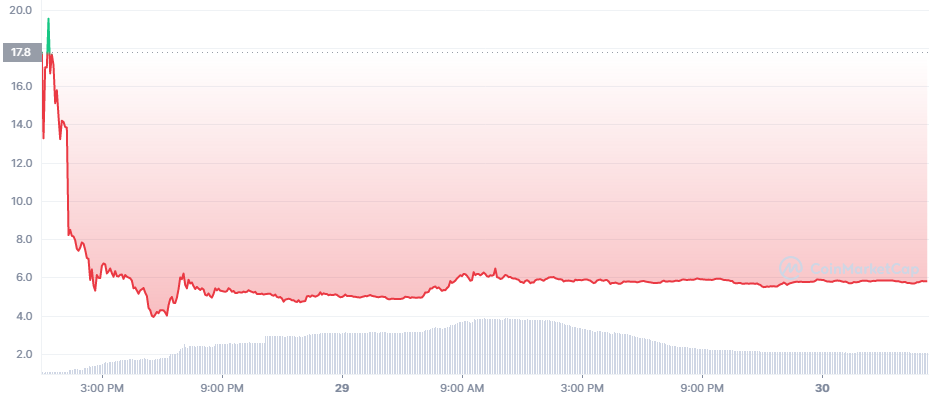LUNA 2.0: What to Know About This Project

LUNA 2.0 is here, as an airdrop based on a previously agreed ratio, based on Proposal 1623. The goal was to launch the genesis block of a brand-new blockchain and a new token, which would be generated and airdropped to former owners of Terra Classic and UST.
LUNA was preserved as a ticker, though the new network removed UST and the potential for LUNA-backed token generation.
Unfortunately, the new LUNA sank immediately, erasing 80% of its value. The Terra community was quick to vote for proposal 1623, and previously for attempts to prop up UST value. But this is not working to save the project and return its reputation.
LUNA, to be distinguished from Luna Classic or LUNC, initially started trading high and peaked at $19.53. Quickly, LUNA fell to $5.70, also dipping under $5 for a stretch. Overwhelming skepticism sees the asset erase most of its value again, and as a meaningless investment.
Exchanges Take Up the New Token
Despite the crash, some of the exchanges that carried LUNA returned for the new token. Binance refused to participate this time, while Kraken listed the new LUNA almost immediately. Huobi was also among the big markets letting Terra have a second chance.
The Binance exchange will follow a more winding path to relisting LUNA. The new asset will be added to the Innovation Zone, a market reserved for new projects with a riskier profile. Binance trading will return on May 31.
Nearly half of the new LUNA trading is happening on KuCoin, the most active South Korean exchange. The listing and activity reflects the fact that an estimated 100K Korean investors trusted Terra. But buyers also came from the USA and other regions, trusting what looked like a fast-track blue-chip token.
Terra was a rare project where an attempt was made to repair the asset and relaunch the blockchain. In the past, crashes to zero were often followed by no communication from the team. Do Kwon, the project’s founder, is still visible on social media, despite an investigation launched for promising outsized returns.
Based on self-reported airdrops, there are 210M new LUNA in circulation, out of a total 1B tokens. With some limited exchange access, the new asset will go through a new price discovery period, testing the appeal of the new network.
Solana and Avalanche Take Step Back
SOL and AVAX, two assets that moved in unison with LUNA, are now backtracking. SOL reached $44.74 and is on track to leave the top 10 of assets. AVAX is down to $25.86, retaining some of the value as the Avalanche C-Chain is a network now adopted for gaming and other decentralized purposes.
Celsius (CEL) remains at $0.57, after proving no exposure to Terra. So far, the fears of a panic run on Celsius were unfounded. The overall attitude is that the current state of DeFi will start to slow down and deflate.
TRON Continues Unaffected
TRON (TRX) retained its position at $0.081, while growing the supply of its native USDD coin. The USDD supply is now above 602M, growing rapidly each day.
The Huobi exchange also added six new TRON-based tokens, with USDD trading pairs.
Having zero fees and an incentive to trade may boost the TRON ecosystem in the coming days. For now, TRX remains little changed, not rallying to a much higher range.
Will BTC Lead the Market Again
The big question is what direction the crypto market is preparing to take. In the last price drop, Bitcoin (BTC) seemed to decouple from altcoins and DeFi project tokens.
BTC dipped under $29,000 during the weekend, but recovered quickly. Low volumes prevented new price moves. Even at this price, market cap dominance is at 45.8%, levels not seen since 2021. BTC traded on very slim volumes of $16B in the past 24 hours, suggesting the new working week trading may boost activity and set a new price direction.
BTC now expects to break the eight-weeks losing trend, possibly after closing the CME futures gap and attempting a new upward movement. However, if BTC fails, a dip to $23,000-$21,000 is still considered a highly probable development.
Even Tether (USDT) saw its volumes slashed to 32B in 24 hours, about half the usual activity. USDT activity is also at a one-month low. The USDT supply is going down to 72.5B tokens, unwinding some of the previous buying.
USDT is now showing net inflows to exchanges, while other major coins have net outflows.
Skepticism about Ethereum (ETH) keeps prices depressed at around $1,800. Still, Web3 and NFT projects continue to appear, trying to build games or other apps of value on the Ethereum blockchain.

Uphold makes buying crypto with popular currencies like USD, EUR and GBP very simple with its convenient options to swap between crypto, fiat, equities, and precious metals.

With over 50 coins and an obsession with security, Kraken is one of the safest places to buy and trade crypto.

Kraken has a good reputation for security and protection of your funds and operates across the USA (except NY), Canada, the EU and Japan

Based in Charleston, South Carolina. Serves over 184 countries and has done over $4 billion in transactions. Offers convenient options to swap between crypto, fiat, equities, and precious metals.

Crypto gets a lot of criticism sometimes but what sort of job are the current banks doing at looking after their customers. Who are the best and the worst banks to be with?

Is mining crypto still profitable? With more cryptos like Ether switching to POS is the competition going to get too much?

The leader in programmable money, smart contracts and decentralised applications. There have been many copycats but none have the community and level of adoption.

The first cryptocurrency. It has limitations for transactions but it is still the most popular being secure, trusted and independent from banks and governments.